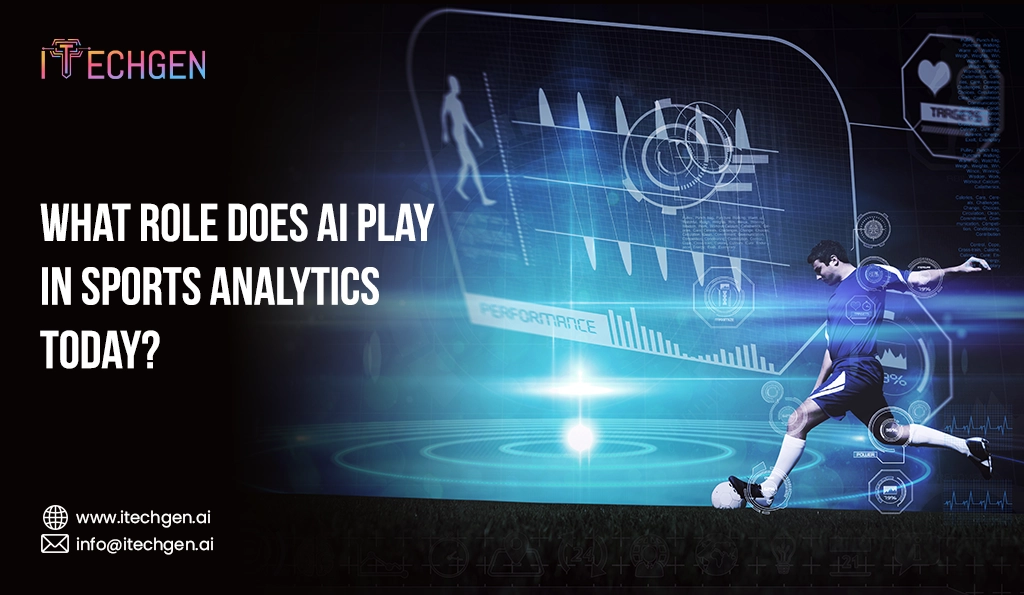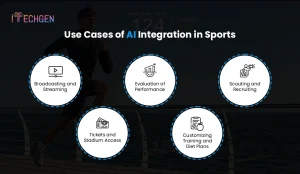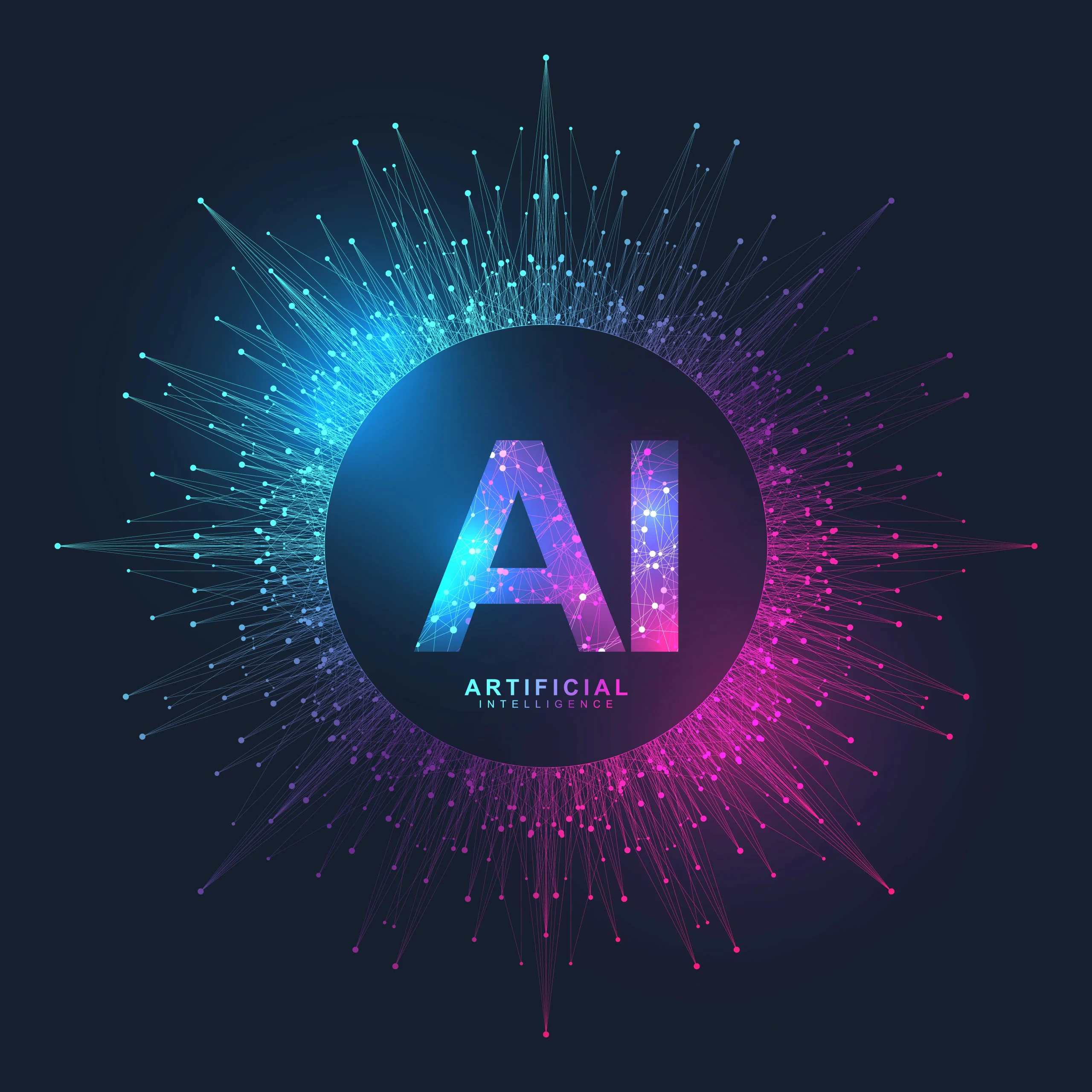How AI is Revolutionizing Sports Analytics in 2025

In the past twenty years, artificial intelligence (AI) has profoundly transformed the way we play, watch, and analyze sports. Gone are the days when AI was confined to post-game statistics; it is now an existing real-time tactical tool that inspires athletes, broadcasters, coaches, sponsors, and fans.
The global sports analytics market is predicted to grow at a compounded annual growth rate (CAGR) of over 20% between 2022 and 2031. The size of the market is estimated to have reached just under 3.2 billion U.S. dollars in 2022, with the expected size to be nearly 16.5 billion U.S. dollars by 2031.
At iTechGen, we’ve seen firsthand how incorporating AI into sports not only improves athletic performance but also opens up immersive fan experiences and data-driven decision-making. In this blog, we look at the importance of AI in the sports sector and dissect primary use cases, with emphasis on the importance of AI development services in this fast-growing area.
Key Applications of AI in Sports

AI and machine learning development has redefined the game both on and off the field, empowering smarter strategies, immersive fan experiences, and futuristic sports management solutions.
- Broadcasting and Streaming
AI is increasing the way sports are watched and consumed. From camera angle automation to live commentary customization, AI makes viewers’ experience more personal. Sophisticated algorithms can interpret fan sentiment and modify the camera stream or highlight clips to suit. For instance, IBM Watson has been utilized at big tennis tournaments to create real-time highlight reels based on audience noise and match-ups.
- Performance Evaluation
Today’s modern sports can more accurately be called data-driven sports, whose entire operations can be managed by constantly eliminating and reflecting on data and AI’s ability to access large data sets in real-time. AI-driven systems use computer vision and apply machine learning on things like player location, successful passes, the probability of scoring and countless other performance metrics. AI allows a coach or performance analyst the ability to isolate weaknesses and engineer improvements as part of their contribution for improved gameplay during competitive sports.
- Scouting and Recruiting
Scouting previously depended largely on subjective judgments. Currently, AI-based machine vision systems can monitor players’ actions and analyze skills in real time. Clubs have access to complete profiles taking into account speed, endurance, technique, and even mental toughness in pressure situations. Objective information aids in more reliable judgments regarding recruitment and player improvement.
- Ticketing and Stadium Access
AI-driven facial recognition systems are being deployed that replace physical tickets and allow the fans’ entry and exit from the stadium. This gets fans into the venue quickly, improves security and safety (as it seems to be needed in our post-COVID world), and provides the all-important fan experience, while also dovetailing with smart parking, food orders, fan experiences and merchandise.
- Personalized Training and Diet Plans
AI programs look at the physiology, sleep and performance trends for each athlete to tailor training and nutrition programs. For example, if a basketball player needs to improve their agility, a program addressing lateral movement and response time will be provided. These recommendations reduce injury risk while improving athletic performance.
- Customized Training Programs
Historically, runners have used their coaches’ instincts and experience. But now AI improves these rituals by making them more scientific and personalized. AI systems study running velocities, response times, endurance levels, and even stress levels to design hyper-personalized training plans.
Example: A sprinter who needs to enhance explosive starts can be given a personalized regimen that enhances fast-twitch muscle growth. A soccer player whose endurance is on the wane can be given routines that target aerobic capacity and recovery.
- Fatigue and Stress Monitoring
Injuries can ruin seasons, careers, and whole campaigns. AI foresees possible injuries by monitoring biomechanics and muscle stress levels. A slight alteration in a basketball player’s jump or foot angle, for instance, may be an indicator of fatigue or strain, which triggers preventive measures.
By integrating wearables and AI analytics, teams can:
- Reduce injury rates
- Optimize recovery time
- Monitor the effectiveness of rehab programs
Case Study: Injury Prevention with AI
Injury prevention is amongst the biggest impacts AI can have on sports. By implementing AI-enabled sensors and wearables into training sessions, teams can now monitor the biomechanics, stress and load indicators of their athletes in real time. With monitoring solutions to detect early signs of overuse or impending injury-related stress, clubs can make adjustments to their training load and other factors, including individual player workload, long before players start showing symptoms.
Those clubs (at all levels) that have adopted this type of approach have reported significant reductions in training-related injuries to athletes. Early intervention to treat injuries not only results in athletes being fresher for games but also improves the overall performance of the team and saves medical costs throughout the season.
Real-Time Game Analysis
Professional sports are predicated on the time value of decision-making, and AI helps facilitate that process. All real-time input from cameras and sensors will produce an AI system that measures players’ spatial locations, the positions of the ball, formations, and who has possession of the ball. Each of the inputs will help coaches better manage the tactical decisions they need to make during a game.
For instance, if a defender is found to always lose space on one flank by an AI system, coaches can rotate player duty or modify formations during the game to offset the deficiency—wherein teams receive a competitive advantage.
Enhanced Metrics to Analyze Players
AI enables teams to move well beyond common stats such as goals and assists. With computer vision and data analytics driving enhanced metrics, sports organizations are now able to analyze:
- Distance covered at sprint speed
- Defensive pressure success rate
- Touch quality and pass efficiency
- Support movement during counterattacks
These essential measurements are valuable for performance assessment, tactics, and player advancement. Coaches can have a better understanding of every player’s role and can make tactical decisions more effectively with a better understanding of what is happening on the field.
Predicting Match Outcomes
AI models are able to predict match outcomes based on a myriad of variables-history performance data, teams’ makeup, weather, pitch and even players’ psychological makeup (through tone of voice or facial analysis). Predictive modeling does not just have usefulness for fans and sports betting enthusiasts – it is useful for coaches and tacticians planning for upcoming matches too.
Example: If AI indicates a greater risk of performance failure in the fourth quarter due to fatigue, a coach might consider their substitution tactics or their training workload leading into the match. Information like this allows teams to best prepare for and exploit their opponents vulnerabilities.
AI & Data Analytics: The Future of Sports
AI and data analytics will innovate the sports industry until the end of time. In the next phase of this evolution, traditional AI technologies will be integrated with emerging technologies—augmented reality, real-time data acquisition, behavioral analytics, and more, changing the way that teams train, compete, perform, and engage with fans.
-
Virtual Reality (VR) Training Rooms
The future of athletic training is immersive and data-rich. Players will be able to train in realistic game conditions using AI plasticity VR without physically stepping on the field. AI will process an athlete’s movement patterns in these simulated environments and provide instantaneous data on reaction time, game decisions, and athletic technique. Quarterbacks will be able to practice high-pressure situations, batters will be able to see pitches virtually, and defenders will be able to engage in drills featuring AI-generated opponents—all with constructive preparation and no injury risk.
-
AI-Generated Game Highlights
No longer will humans have to tediously edit videos. Artificial intelligence with computer vision and deep learning capabilities will automatically detect highlight-worthy moments—high-pressure plays, goals, fouls—and create customized highlight reels for various groups. You could be a fan simply looking for the play of your favorite player or a coach analyzing tactics, and AI-generated clips will provide you with content specifically for your purposes in seconds.
-
Smarter Draft Decisions
Drafting players will no longer involve just stats and scouting reports. Artificial intelligence will instead rank future recruits on a comprehensive data profile of playing style, team chemistry fit, psychological toughness, and even tendencies of social behavior. Predictive models will help managers assess how well players will fit into their systems and culture—lessening the risk of expensive mistakes in recruitment.
-
Hyper-Personalized Fan Experiences
AI will increase fan interaction by providing customized experiences both on the internet and in the stadium. Machine learning algorithms will scan fan activities—purchases, app usage, and most loved teams/players—to provide customized content, seat upgrades, merch suggestions, and push notifications for game highlights. Picture this: entering a stadium and getting a welcome message, your favorite snacks at your seat, and live statistics specific to your interests—all thanks to AI.
-
Real-Time Coaching Assistants
In the future, AI may serve as a real-time coach assistant—analyzing a game in real-time while providing teams with tactical options even while a play is taking place. These machines will have the ability to process thousands of variables each second, giving teams spatial analytical capacity in an instant they may miss.
Ethical Challenges & Data Security in Sports AI
As AI becomes more incorporated into the sports ecosystem, it also raises some significant ethical and data security issues. Clubs and tech companies have a significant responsibility to ensure that the vast amounts of sensitive data—biometric data and medical histories, GPS tracking and psychological assessments—that organizations are collecting haven’t been misused or resulted in unanticipated injury. Important ethical issues include:
Key Ethical Concerns:
- Sensitive Data Misuse: Biometric and health information related to an athlete can be abused through a lack of precautions & protections. Poor management or security issues could potentially harm player careers, contract negotiations, or mental health.
- Breach of Privacy Laws: Collecting and processing personal data without satisfying the privacy regulations, such as GDPR, or local data protection laws could result in legal action or a loss of trust.
- AI Models may exhibit Bias: AI systems may lead to biased evaluations if trained on non-representative or biased training data. This could lead to unfair recruitment decisions, unjustified benching, or devaluing a player based on race, gender, or background.
What Can Be Done?
Transparency: The organization must clearly state what data is being collected, why they need it, how it will be used and who will have the data. Players and fans should never be kept in the dark about how their personal information is utilized.
Consent-Based Data Collection: Informed consent should be a must-have standard. Athletes must be able to agree to share their data voluntarily, and they must have the ability to opt out or revoke access to it without penalties.
Strong Data Encryption & Cybersecurity Measures: Strong encryption and security measures for data stored or transmitted are critical. End-to-end encryption, multi-layered access controls, and secure cloud environments will help to prevent unauthorized access and cyberattacks.
Regular Audits, Ethical Assessments, and Oversight: Teams and technical providers follow the practice of regularly auditing their AI systems to identify biases and potential inequity – this is crucial. An independent ethics committee or governance board could further help the organization, the players, and prospects maintain ethical practices.
Final Words
Artificial intelligence is no longer on the horizon—it’s a disruptive force already revolutionizing the sports industry in all aspects. From improving performance and reducing injury risk to creating hyper-personalized experiences for fans and enhancing group operations, AI is changing how the world will continue to engage with sports. Teams, coaches, broadcasters, and even fans have access to what can only be described as a continuous stream of new insights and innovations, many of which were beyond anyone’s imagination 10 years ago. The real-time analysis, predictive capabilities, and plans generated from the data in the near real-time genre change the way you and your organization can operate in a competitive space. As machine learning, computer vision, and natural language processing (NLP) technology continues to improve, the applications are likely to become more sophisticated. Capitalizing on the progress with technology is not about raising the bar. It is about understanding that today will set the pace for what is next. For organizations wanting to be looked up to, not just the organization keeping pace, adopting AI-enabled solutions now is the best approach to create a successful future.

FAQ:
Q1: How is AI used in sports today?
AI is an important aspect of multiple areas of sports, such as player tracking, injury prediction, scouting, analysis, and content generation. AI can assist coaches with data-driven approaches, help broadcasters develop curated viewing experiences, and provide fans with interactive opportunities to engage with their teams and games through smart highlights and recommendations.
Q2: Which sports use AI the most?
AI is used primarily in sports like football (soccer), basketball, tennis, and baseball due to the quantity of data available from these sports. AI is even used to gain a competitive advantage in areas like motion tracking, strategy, avoiding injuries, and improving the fan experience. Sports at the pro level, like baseball, basketball, and soccer leagues (like the Premier League), have begun to lead the way with AI in sports.
Q3: Can AI reduce sports injuries?
Yes, AI can mitigate the risk of sports injuries through monitoring biomechanics, movement patterns, stress, and other variables to continuously observe your athlete’s status. It can catch early signs of fatigue or balance problems so that you can warn your staff before any injury occurs. This way you can rest, rehabilitate, and modify training programs before your athletes sustain injuries.
Q4: Is AI replacing human coaches or scouts?
No, AI isn’t replacing coaches or scouts, if anything it’s empowering them. AI processes complex data far quicker and when combined with AI’s powerful analytic capabilities, it provides insights into things like player form, opponent tactics and game structure. But nothing can substitute for the insight, knowledge, experience of human experts when it comes to interpreting the insights generated by AI, or making the final call.

Pankaj Arora (Founder & CEO)
Pankaj Arora is the Founder & CEO of iTechGen, a visionary leader with a deep passion for AI and technology. With extensive industry experience, he shares expert insights through his blogs, helping businesses harness the power of AI to drive innovation and success. Committed to delivering customer-first solutions, Pankaj emphasizes quality and real-world impact in all his endeavors. When not leading iTechGen, he explores emerging technologies and inspires others with his thought leadership. Follow his blogs for actionable strategies to accelerate your digital transformation and business growth.
View More About Pankaj Arora
